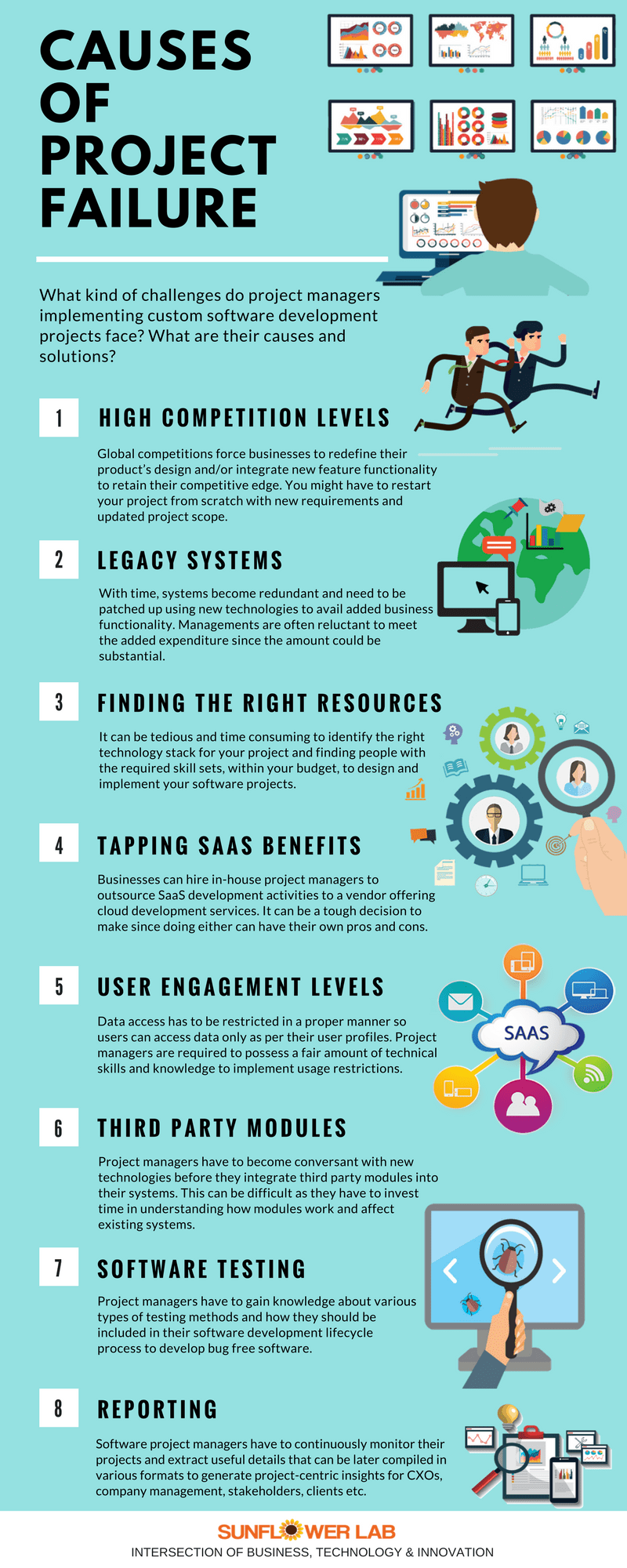What kind of challenges do project managers implementing custom software development projects face?
Businesses, big and small alike, have to adopt the latest industry trends and follow them vigorously if they’re to survive the competition. Technologies aid process automation, and help to improve work processes so the quality of deliverables can be refined and businesses can offer better services and products to their customers. However, technologies need to be managed in a proper manner before their benefits can be reaped. Project management methodologies help to streamline the custom software development process and manage projects of all sizes and shapes. And, in addition, control the complexity levels to improve the project completion rates.
Software development is no different. Projects involving cloud computing, in-house development of products and services, infrastructure related, product enhancement and upgrades, web-based solutions, mobile app development etc. are a constant in the software industry. The industry is highly volatile and businesses have to rapidly adapt to changing work environments, and simultaneously evolve their products on a perpetual basis to retain their marketing hold.

The challenges are many:
- Design effective strategies and plans to overcome global competition
- Replace legacy systems and infrastructure with modern ones
- Adopt new technologies to reduce time-to-market
- Leverage SaaS benefits to improve business processes
- Outsourcing or in-sourcing the software development process
- Hire people with proper skill sets to upkeep in-house tech processes
- Generate ROI on a consistent basis
Here’re eight main challenges that affect software project managers and management practices.
1. High competition levels owing to globalization
If your business relates to developing software projects, or you’re a part of the software industry, typically you would be building software solutions or offering software related services. In either of the cases, your product or services shall face high market competitions, and while you’re still developing your product or services, you competitors could be, or would have already designed a similar product or service – If they haven’t already done so. It becomes imperative to shorten your time-to-market so you can start monetizing your offerings at the soonest. Moreover, businesses also need to work upon other parameters affecting the ROIs such as product pricing structures, customer engagement and retention, service level agreements etc.
Just as other projects do, software projects require a well-defined scope and a set of fixed objectives to target the quality and quantity of deliverables. The project management process can function in a streamlined manner as long as the project scope and the nature of deliverables doesn’t change. Global competitions often forces businesses to redefine their product’s design and/or integrate new feature functionality into existing products to retain their competitive edge in the market. This drastically affects the software project management process, and if you’re following traditional Waterfall methods for managing your projects, you might have to restart your project from scratch with a new set of end user requirements and an updated project scope.
Project managers have to work closely with business owners to understand their current market-related needs as well as anticipate future project related issues and problems. Following Agile and Lean software project management principles can help you prepare and adapt to evolving work-related environments and frequently changing end user requirements.
2. Legacy systems and infrastructure issues
Businesses invest significant amount of funds in designing and maintaining systems to automate their in-house and other processes. However, over time, systems tend to become redundant and require to be patched up or replaced using new technologies to avail added business functionality. Managements are often reluctant to meet the added expenditure since the amount could be substantial. In certain cases, software businesses might not even be in a position to afford revamping their tech stacks owing to funds scarcity. As a result project managers have to do with existing technology stacks and continue using out-dated tools and software processes to fulfill their project management objectives.
Project mangers, therefore have to educate the management about the benefits of using disruptive technologies and restructuring existing projects by transforming to newer, more effective software platforms and tools. It is important to get the buy-in since the company might lose its competitive edge in the market by developing solutions that no longer fulfill end user requirements.
3. Finding the right project management resources and skilled talent pool
It can be tedious and time consuming to identify the right technology stack for your project and finding people with the required skill sets, within your budget, to design and implement your software projects. Large organizations can have varied business process, each requiring a skilled project manager having enough experience to design, implement, monitor and streamline the projects. At times, it can be difficult to find such managers, especially those which have the required skill sets and still meet your budget restraints.
By hiring project managers who’re affordable but lack the necessary skills, businesses may compromise upon the quality and quantity of the project deliverables which can inversely affects ROI creation. Managements need to hire resources who can effectively maintain the deliver pipeline in a timed and organized manner so both quality and quantity aspects are met and the business can promote new products and services in tune with their marketing and sales plan.

4. Tapping SaaS benefits
Monolithic software systems are being replaced by SaaS platforms, thus helping small and mid-sized businesses to avail large enterprise level capabilities. More and more companies are subscribing to the SaaS model to benefit from advanced and more reliable technologies that can help them build applications that are robust, scalable, flexible, end user oriented and easy to maintain. A large chunk of the custom software development budget can therefore be redirected to other projects and processes that can add more value to business strategies.
Businesses have the choice to hire in-house project managers to oversee SaaS development activities or outsource the entire development process to a SaaS vendor offering cloud development services. It can be a tough decision to make since doing either can have their own pros and cons – While managements don’t have to invest extra funds to scale up their processes by employing software project managers, hiring SaaS vendors can mean recurring development costs which may add on substantially to the annual spending.
5. User engagement levels and GAAP
Based upon your business model and offerings, you could have a large number of individuals accessing your system at various levels of engagement. Both in-house personnel and customers may share the same web application to access data, however, not all users can access each and every piece of data available in the system. Data access has to be restricted in a proper manner so users can access data only as per what their user profile allows them to do. The project manager ideally decides and allocates usage rights to computer systems.
Since some businesses employ user-specific or role-based engagement models within their systems, managers should possess a fair amount of technical skills as well as knowledge to implement usage restrictions and internal controls in the systems. This is especially true if you’re implementing financial systems and need to support GAAP (Generally Accepted Accounting Principles) standards within United States.
6. Using third party modules and pre-built processes
Technologies keep on advancing by leaps and bounds, and software vendors tap their potential to build third party integration modules offering pre-defined functionality. These modules can drastically reduce the development time and since they’re tested, they can be safely integrated in existing systems. Business processes can be bettered and the turn-around time can be drastically reduced by using such third party modules.
Project managers have to become conversant with new technologies before they integrate third party modules into their systems. This can increase the stress levels, as managers are often forced to invest special time in understanding how such modules work, how they’ll affect their existing systems and how the quality of deliverables can be improved by using them. They have to do this in addition to their routine managerial activities.
7. Software testing and quality control
Business process modules and functionality have value only when they’re tested thoroughly for bugs and defects. Reliability is an important criterion in software development, and project managers are required to focus upon implementing stringent quality tests within their software development cycle to ensure the project deliverables are reliable and can fulfill the objectives for which they’re built for.
There can be several types of tests to ensure the quality of software. Some of them are:
- Unit Testing
- Integration Testing
- Functional Testing
- System Testing
- Stress Testing
- Performance Testing
- Usability Testing
- Acceptance Testing
- Regression Testing
- Beta Testing
Project managers have to gain knowledge about various types of testing methods and how they should be included in their software development life cycle process to develop bug free software. Since more than one testing method may be required to test software, and the type of tests may vary based upon the development platform i.e. web based apps, mobile apps, cloud based apps, monolithic platforms etc., managers might be required to deal with more complexity levels, and spend more time and efforts to supervise the development process.
8. Reporting to clients/management
A project manager is responsible for starting a project, planning and designing it, implementing the project, and subsequently monitoring, evaluating and controlling it. A custom software development project manager also “closes” a project. They have to generate certain reports to ensure the project’s status is properly conveyed to the management and team members. The reports help shareholders and managements to ascertain if the project is heading in the correct direction, and whether it shall fulfill the objectives for which it is created.
Some of the project report-types are:
- Time sheet Report – Useful for monitoring resource availability for development related tasks.
- Expense Report – Valuable throughout the project as it provides insights into work related overheads such as subscription amounts for tools and other fixed or recurring costs.
- Resource Workload Report – For scheduling resource across projects and measuring budget impacts.
- Portfolio Report – Multiple views of the project status, health and resources utilized in the project.
Project Status Report – A report containing a project’s overall health. - Risk Reports – Detailing the risks in a project and how they can be mitigated.
- Board/Executive Reports – Weekly status update that goes to your project team and key business stakeholders.
Custom software development project managers have to continuously monitor their projects and extract useful details that can be later compiled in various formats to generate project-centric insights for various entities such as CXO level executives, company management, stakeholders, clients etc. The monitoring process can consume a lot of time, and managers are also required to interact with various individuals to answer their reports related queries.
You might also like
Stay ahead in tech with Sunflower Lab’s curated blogs, sorted by technology type. From AI to Digital Products, explore cutting-edge developments in our insightful, categorized collection. Dive in and stay informed about the ever-evolving digital landscape with Sunflower Lab.





